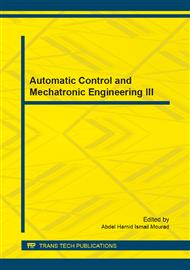[1]
J. Yan, C. Guo, X. Wang, A dynamic multi-scale Markov model based methodology for remaining life prediction, Mechanical Systems and Signal Processing, 25 (2011) 1364-1376.
DOI: 10.1016/j.ymssp.2010.10.018
Google Scholar
[2]
V. T. Tran, H. T. Pham, B. S. Yang, T. T. Nguyen, Machine performance degradation assessment and remaining useful life prediction using proportional hazard model and support vector machine, Mechanical Systems and Signal Processing, 32 (2012).
DOI: 10.1016/j.ymssp.2012.02.015
Google Scholar
[3]
S. Dong, T. Luo, Bearing degradation process prediction based on the PCA and optimized LS-SVM model, Measurement, 46 (2013) 3143-3152.
DOI: 10.1016/j.measurement.2013.06.038
Google Scholar
[4]
C. Chen, G. Vachtsevanos, Bearing condition prediction considering uncertainty: An interval type-2 fuzzy neural network approach, Robotics and Computer Integrated Manufacturing, 28 (2012) 509-516.
DOI: 10.1016/j.rcim.2012.02.005
Google Scholar
[5]
Z. Tian, An artificial neural network method for remaining useful life prediction of equipment subject to condition monitoring, Journal of Intelligent Manufacturing, 23 (2012) 227-237.
DOI: 10.1007/s10845-009-0356-9
Google Scholar
[6]
C. Chen, G. Vachtsevanos, M. E. Orchard, Machine remaining useful life prediction: An integrated adaptive neuro-fuzzy and high-order particle filtering approach, Mechanical Systems and Signal Processing, 28 (2012) 597-607.
DOI: 10.1016/j.ymssp.2011.10.009
Google Scholar
[7]
Y. Pan, J. Chen, X. Li, Bearing performance degradation assessment based on lifting wavelet packet decomposition and fuzzy c-means, Mechanical Systems and Signal Processing, 24 (2010) 559-566.
DOI: 10.1016/j.ymssp.2009.07.012
Google Scholar
[8]
P. J. Vlok, M. Wnek, M. Zygmunt, Utilising statistical residual life estimates of bearings to quantify the influence of preventive maintenance actions, Mechanical Systems and Signal Processing, 18 (2004) 833-847.
DOI: 10.1016/j.ymssp.2003.09.003
Google Scholar
[9]
Z. Tian, L. Wong, N. Safaei, A neural network approach for remaining useful life prediction utilizing both failure and suspension histories, Mechanical Systems and Signal Processing, 24 (2010) 1542-1555.
DOI: 10.1016/j.ymssp.2009.11.005
Google Scholar
[10]
J. Lee, H. Qiu, G. Yu, J. Lin, Bearing data set, IMS, University of Cincinnati, NASA Ames Prognostics Data Repository, Rexnord Technical Services, (2007).
Google Scholar


